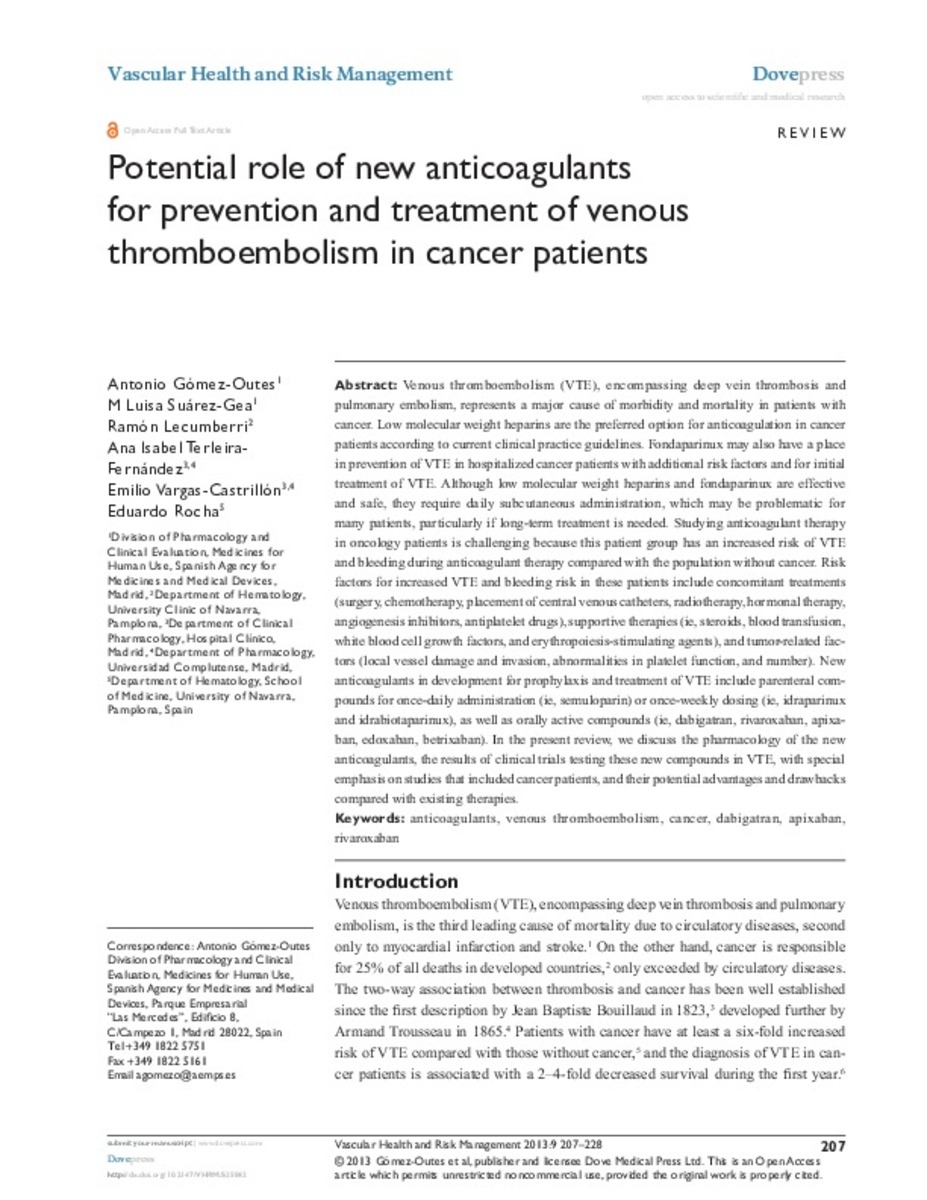Full metadata record
| DC Field | Value | Language |
|---|---|---|
| dc.creator | Gomez-Outes, A. (Antonio) | - |
| dc.creator | Suarez-Gea, M.L. (M. Luisa) | - |
| dc.creator | Lecumberri, R. (Ramón) | - |
| dc.creator | Terleira-Fernandez, A.I. (Ana Isabel) | - |
| dc.creator | Vargas-Castrillon, E. (Emilio) | - |
| dc.creator | Rocha, E. (Eduardo) | - |
| dc.date.accessioned | 2014-07-15T11:18:46Z | - |
| dc.date.available | 2014-07-15T11:18:46Z | - |
| dc.date.issued | 2013 | - |
| dc.identifier.citation | Gómez-Outes A, Suárez-Gea ML, Lecumberri R, Terleira-Fernández AI, Vargas-Castrillón E, Rocha E. Potential role of new anticoagulants for prevention and treatment of venous thromboembolism in cancer patients. Vasc Health Risk Manag. 2013;9:207-28. | es_ES |
| dc.identifier.issn | 1176-6344 | - |
| dc.identifier.uri | https://hdl.handle.net/10171/36164 | - |
| dc.description.abstract | Venous thromboembolism (VTE), encompassing deep vein thrombosis and pulmonary embolism, represents a major cause of morbidity and mortality in patients with cancer. Low molecular weight heparins are the preferred option for anticoagulation in cancer patients according to current clinical practice guidelines. Fondaparinux may also have a place in prevention of VTE in hospitalized cancer patients with additional risk factors and for initial treatment of VTE. Although low molecular weight heparins and fondaparinux are effective and safe, they require daily subcutaneous administration, which may be problematic for many patients, particularly if long-term treatment is needed. Studying anticoagulant therapy in oncology patients is challenging because this patient group has an increased risk of VTE and bleeding during anticoagulant therapy compared with the population without cancer. Risk factors for increased VTE and bleeding risk in these patients include concomitant treatments (surgery, chemotherapy, placement of central venous catheters, radiotherapy, hormonal therapy, angiogenesis inhibitors, antiplatelet drugs), supportive therapies (ie, steroids, blood transfusion, white blood cell growth factors, and erythropoiesis-stimulating agents), and tumor-related factors (local vessel damage and invasion, abnormalities in platelet function, and number). New anticoagulants in development for prophylaxis and treatment of VTE include parenteral compounds for once-daily administration (ie, semuloparin) or once-weekly dosing (ie, idraparinux and idrabiotaparinux), as well as orally active compounds (ie, dabigatran, rivaroxaban, apixaban, edoxaban, betrixaban). In the present review, we discuss the pharmacology of the new anticoagulants, the results of clinical trials testing these new compounds in VTE, with special emphasis on studies that included cancer patients, and their potential advantages and drawbacks compared with existing therapies. | es_ES |
| dc.language.iso | eng | es_ES |
| dc.publisher | Dove Medical Press | es_ES |
| dc.rights | info:eu-repo/semantics/openAccess | es_ES |
| dc.subject | Anticoagulants | es_ES |
| dc.subject | Apixaban | es_ES |
| dc.subject | Dabigatran | es_ES |
| dc.subject | Cancer | es_ES |
| dc.subject | Venous thromboembolism | es_ES |
| dc.subject | Rivaroxaban | es_ES |
| dc.title | Potential role of new anticoagulants for prevention and treatment of venous thromboembolism in cancer patients | es_ES |
| dc.type | info:eu-repo/semantics/article | es_ES |
| dc.identifier.doi | http://dx.doi.org/10.2147/VHRM.S35843 | es_ES |
Files in This Item:
Statistics and impact
Items in Dadun are protected by copyright, with all rights reserved, unless otherwise indicated.






